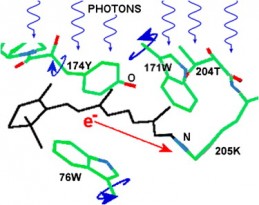New light on how the retina sees
July 4, 2011
Syracuse University researchers have shed new light on how the vision process is initiated: by the redistribution of electrons on chromophores (light-absorbing substances in retinal photoreceptor molecules).
This occurs during the first few femtoseconds (one-quadrillionth of a second) after light enters the eye, they found. Their experiments showed that when a chromophore absorbs a photon of light, electrons move from the chromophore’s “free” end to the place where it attaches to opsin.
The movement of the electrons causes a change in the electrical field surrounding the chromophore. That change is detected by nearby amino acids that are highly sensitive to changes in the electrical field. These amino acids, in turn, signal a rhodopsin molecule to initiate the visual process.
Ref.: Koji Nakanishi, Evidence from Chlamydomonas on the Photoactivation of Rhodopsins without Isomerization of Their Chromophore, Chemistry and Biology, Volume 18, Issue 6, 733-742, 24 June 2011 [DOI: 10.1016/j.chembiol.2011.04.009]
